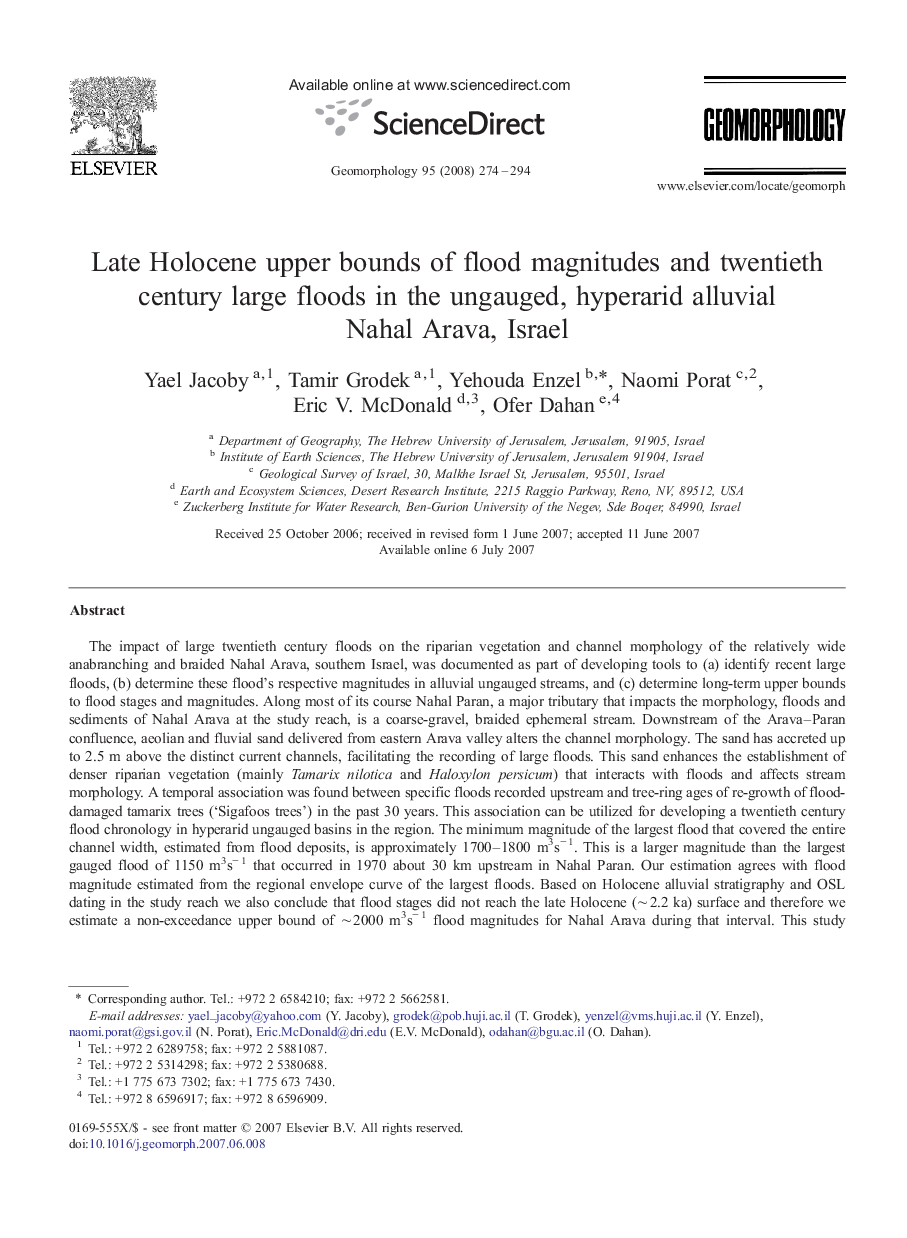| کد مقاله | کد نشریه | سال انتشار | مقاله انگلیسی | نسخه تمام متن |
|---|---|---|---|---|
| 4686867 | 1635562 | 2008 | 21 صفحه PDF | دانلود رایگان |
عنوان انگلیسی مقاله ISI
Late Holocene upper bounds of flood magnitudes and twentieth century large floods in the ungauged, hyperarid alluvial Nahal Arava, Israel
دانلود مقاله + سفارش ترجمه
دانلود مقاله ISI انگلیسی
رایگان برای ایرانیان
کلمات کلیدی
موضوعات مرتبط
مهندسی و علوم پایه
علوم زمین و سیارات
فرآیندهای سطح زمین
پیش نمایش صفحه اول مقاله

چکیده انگلیسی
The impact of large twentieth century floods on the riparian vegetation and channel morphology of the relatively wide anabranching and braided Nahal Arava, southern Israel, was documented as part of developing tools to (a) identify recent large floods, (b) determine these flood's respective magnitudes in alluvial ungauged streams, and (c) determine long-term upper bounds to flood stages and magnitudes. Along most of its course Nahal Paran, a major tributary that impacts the morphology, floods and sediments of Nahal Arava at the study reach, is a coarse-gravel, braided ephemeral stream. Downstream of the Arava-Paran confluence, aeolian and fluvial sand delivered from eastern Arava valley alters the channel morphology. The sand has accreted up to 2.5 m above the distinct current channels, facilitating the recording of large floods. This sand enhances the establishment of denser riparian vegetation (mainly Tamarix nilotica and Haloxylon persicum) that interacts with floods and affects stream morphology. A temporal association was found between specific floods recorded upstream and tree-ring ages of re-growth of flood-damaged tamarix trees ('Sigafoos trees') in the past 30 years. This association can be utilized for developing a twentieth century flood chronology in hyperarid ungauged basins in the region. The minimum magnitude of the largest flood that covered the entire channel width, estimated from flood deposits, is approximately 1700-1800 m3sâ 1. This is a larger magnitude than the largest gauged flood of 1150 m3sâ 1 that occurred in 1970 about 30 km upstream in Nahal Paran. Our estimation agrees with flood magnitude estimated from the regional envelope curve of the largest floods. Based on Holocene alluvial stratigraphy and OSL dating in the study reach we also conclude that flood stages did not reach the late Holocene (â¼Â 2.2 ka) surface and therefore we estimate a non-exceedance upper bound of â¼Â 2000 m3sâ 1 flood magnitudes for Nahal Arava during that interval. This study indicates that in unfavorable areas the combination of hydrology, fluvial morphology and botanic evidence can increase our understanding of ungauged basins and give information crucial for hydrology planning.
ناشر
Database: Elsevier - ScienceDirect (ساینس دایرکت)
Journal: Geomorphology - Volume 95, Issues 3â4, 15 March 2008, Pages 274-294
Journal: Geomorphology - Volume 95, Issues 3â4, 15 March 2008, Pages 274-294
نویسندگان
Yael Jacoby, Tamir Grodek, Yehouda Enzel, Naomi Porat, Eric V. McDonald, Ofer Dahan,